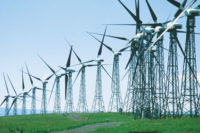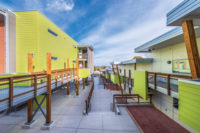As covered by EDC in the May 2011 article “Opening Windows to Cutting-Edge Education,” the Center for Energy Efficient Design (CEED) opened its doors in November 2010, as the first public school in the U.S. built according to Passive House (or Passivhaus) standards, arguably the world’s highest standards in energy-efficient construction. After a full year of operation, this Franklin County Public School, located in Rocky Mount, Va., has exceeded energy performance expectations.
The CEED was designed and built by Adam Cohen, co-owner of Structures Design/Build and one of approximately 250 certified Passive House designers in the U.S. Cohen predicted that the school would use 10,686 kilowatt hours (kWh) of energy annually, which is 68 percent less than the modeled baseline of 31,632 kWh annual energy usage of a standard building. In the CEED’s first year of operation, actual energy usage figures were 10,050 kWh — 6 percent less than the predicted usage. Additionally, a thermal comfort survey was issued among teachers and students who use the building. When asked about comfort levels with air temperature, humidity and air quality during four seasons, the results showed zero percent dissatisfied users. According to Cohen, the survey’s results support the European findings of excellent thermal comfort in Passive House design.
The Passive House Institute U.S. (PHIUS) cites that the rigorous standards of the German-founded Passive House technique reduce energy consumption of buildings by up to 90 percent and achieve overall energy savings of 60-70 percent. Because Passive House design software is extremely accurate, Cohen estimated that the CEED building would achieve similar results, however, the school’s energy performance proved to exceed expectations.
Passive House construction focuses on whole-building performance by constructing a well-insulated, airtight seal. Precise design technique and use of superior energy-efficient products, such as high insulating windows, were essential elements in achieving such impressive energy usage results.
To help seal the building envelope, Ply Gem Windows provided casement, awning and fixed windows with specially designed glass for a total unit R-value of 5. “Passive House design is a fabric-first solution,” says Cohen. “Windows are a huge part of the fabric and a core element of the building.”
The windows were customized with a triple-pane HP UltraSC glass system that combines two panes of multilayered vacuum-deposition, Low-ESH (solar heating) insulating glass with an interior glass substrate and two insulating chambers of krypton gas. While argon gas is a typical window insulator because it’s much denser than air, krypton is almost twice as dense as argon, resulting in a thicker layer of insulation. The resulting U-factors of the insulating glass unit exceed 0.21 in operating units and 0.19 for fixed units.*
The frame of the window incorporates R-Core insulation, made of high-density, solid-polyurethane for even distribution of the insulating barrier. A high-performing Warm Edge spacer system flexes with expansion and contraction to help ensure a strong seal for the life of the window. The spacer design also reduces thermal transfer around the glass perimeter by utilizing a unique U-shaped channel to separate glass panes and to interrupt the natural flow of heat to cold. Additionally, the projecting casement and awning windows help promote long-term air tightness.
Another element of Passive House design is south facing solar orientation to help reduce active heating and cooling. As such, the south facing, triple-glazed solar heating window glass helps optimize passive solar and internal heat gains and increase indoor comfort.
“The windows act as heat generators in the winter, helping to keep the building comfortable for teachers and students,” says Cohen.
Other design techniques and technologies of the CEED include the use of thermal mass, earth-berming, rainwater harvesting, energy-efficient HVAC systems and appliances, lighting controls, solar hot water heaters, wind turbines and photovoltaics.
The CEED building is located on the campus of the Gereau Center for Applied Technology and Career Exploration, a teaching lab that allows each middle school student within the Franklin County Public Schools to explore eight different career tracks that are expected to be in high demand when the students enter the workforce. In conjunction with the Gereau Center curriculum, each middle school student will attend class in the CEED building to learn about the impact of energy efficiency in the 21st century.
The CEED project was originally initiated in 2003 by two teachers from the Gereau Center and was funded through grants, donations from the community, the Franklin County School Board and money saved from the construction of a local elementary school. The center is attempting to meet at least LEED Platinum standards.
The school also serves as a template for residential and commercial construction for the future, educating homeowners, builders and remodelers on how they can apply the techniques to their own projects.
*As tested and certified by the National Fenestration Rating Council (NFRC). Tested window sizes, determined by the NFRC, vary by style.






